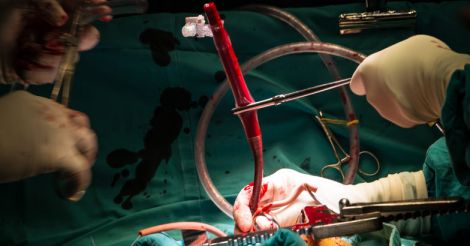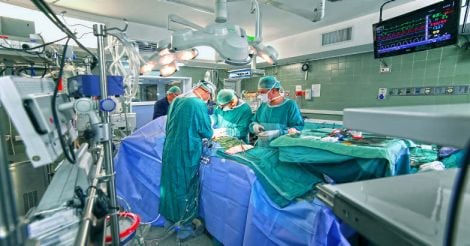The other day, a patient, who was referred to me for a Coronary Artery Bypass Graft (CABG) surgery, wanted to know whether I would do 'beating heart surgery' on him. One of his relative with no medical background had told him that “beating heart surgery” was “better” than conventional bypass surgery, where the operation is performed on a non-beating arrested stand-still heart (the heart is arrested by injecting a cold potassium solution into it – the same injection used to painlessly execute prisoners on death row in the USA).
Also read: Matters of the Heart | Fee-splitting – the unethical side of medical practice today
Since the first CABG was performed in the late 1960s, the standard surgical approach has included the use of cardiac arrest aided by cardiopulmonary bypass (CPB) - using the heart lung machine (“on-pump” CABG) - to perform coronary artery surgery. The heart is basically stopped by injecting a cold potassium solution into it – the same injection used to painlessly execute prisoners in the US.
 The results of multiple studies have shown that “off pump” CABG is associated with less bleeding, less kidney dysfunction, and a shorter hospital cost and stay. Photo: Getty Images
The results of multiple studies have shown that “off pump” CABG is associated with less bleeding, less kidney dysfunction, and a shorter hospital cost and stay. Photo: Getty ImagesHaving the heart not beating helped optimize the conditions for construction of vascular anastomoses to all diseased coronary arteries without cardiac motion or hemodynamic compromise. This on-pump CABG has become the gold standard and is performed in about 85 percent of subjects undergoing the procedure in the United States.
Also read: Matters of the Heart | Coronary artery bypass operations: the basics everyone needs to know
Despite the excellent and well documented results that have been achieved, the use of CPB and the associated manipulation of the ascending aorta are linked with very occasional postoperative complications – mainly strokes, generalized neurocognitive dysfunction (temporary loss of some memory, attention, motor speed, depression etc.), kidney dysfunction, and a generalized body inflammatory response. In an effort to avoid these complications, the so called “off-pump” or “beating heart” CABG was revisited (in the initial days, all heart operations were done on a beating heart, before the heart lung machine was invented). “Off-pump” CABG is performed on the beating heart with the use of stabilizing devices, which minimize cardiac motion. In addition, it incorporates techniques to minimize damage to the heart and to avoid low blood pressure during the procedure. As a result, the need for the heart lung machine is obviated.
No technique is superior to the other
The results of multiple studies have shown that “off pump” CABG is associated with less bleeding, less kidney dysfunction, and a shorter hospital cost and stay. On pump” surgery, however, is associated with more complete revascularization (more grafts are placed than what would what have happened with beating heart surgery – therefore more complete revascularization), better long-term graft patency, and less need of repeat interventions due to blockages of these grafts(requiring stents or re-do surgery).
 Immediately after surgery, there is no difference in complications between either type of surgery in relation to death or major complications – cardiac complications, kidney failure or neurological events. Photo: Getty Images
Immediately after surgery, there is no difference in complications between either type of surgery in relation to death or major complications – cardiac complications, kidney failure or neurological events. Photo: Getty ImagesImmediately after surgery, there is no difference in complications between either type of surgery in relation to death or major complications – cardiac complications, kidney failure or neurological events (stroke, com0a, or neurocognitive deficits). But the long-term deleterious effects, including repeat revascularization procedures, or a non-fatal myocardial infarction occurring within one year of surgery occurred more often in those undergoing “off pump” or “beating heart surgery”.
Despite these results, off-pump CABG is the preferred approach by some surgeons who have extensive experience with it and therefore are comfortable with its technical nuances. This is more so in India, where there are some surgeons who do 100 percent of their CABG’s on a beating heart. Ultimately, most surgeons consider either approach to be reasonable for the majority of subjects undergoing CABG. It is good to have both sets of skills in the armamentarium of a surgeon who is doing large volumes of coronary artery bypass surgeries regularly.
Also check: Matters of the Heart | Should I treat my cholesterol? The controversy over statins
Sadly, many hospitals prefer to employ surgeons who do beating heart surgery. The reason? The profit margins are much more with “beating heart” surgery. Although the patient pays the same amount, the cost of consumables (oxygenator, cardioplegia, etc), which are a significant portion of the expenses, are saved. And many major hospitals in our country employ such surgeons only for making more money.
If one of my close relatives needed surgery? Personally, I would tell him to opt for conventional “on pump” surgery. Our Indian coronary arteries are smaller, and more diffusely diseased than our Western counterparts. I strongly feel a better anastomosis is possible on conventional arrested heart surgery as opposed to beating heart surgery. With proven, better, long-term results.
(The author is a former head of the department of cardiothoracic surgery at Christian Medical College and Hospital, Vellore. He is currently the chief administrative of icer, and head of the cardiothoracic surgery department at Pushpagiri Heart Institute, Tiruvalla.)

























